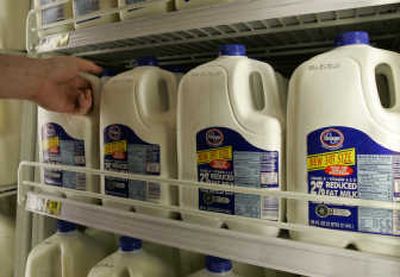Shoppers downsize portions

NEW YORK – Shoppers have been lugging ever-larger products to their ever-bigger cars for years. Now, pinched by the sagging economy, more are embracing a new behavior: buying a little at a time.
From meat to mustard, consumers are trying to control their food bills by buying smaller-size items as they grapple with soaring prices. Companies have taken note, experimenting with different measures such as 3/4-gallon milk jugs and pies that have shrunk to 6 inches.
“I don’t stockpile anymore,” said Lorraine Woodcheke, a publicist from San Francisco, who in January started buying smaller containers of soy milk, olive oil and fresh-cut fruit to control her budget. “I don’t have a pantry that is overflowing. I can’t justify letting food go bad the way I used to.”
Data from research company the Nielsen Co. and retailers that sell fuel show that downsizing is even occurring at the pump, with drivers limiting how much they fill their tank to avoid getting hit with a hefty one-time payment.
Part of it may be psychological: Consumers can’t adjust to having to pay $60 at once to fill their gas tank, or spend $150 on the weekly food bill. Many are also more conscious of being wasteful: Throwing out milk when it was $3 a gallon may not be a big deal, but it’s another matter when it’s $4.
Some consumer advocates warn that the smaller packages are a way for food makers to pass on the increase in ingredient costs. And even if buying smaller means buying more often – and not saving money in the long run – many shoppers feel they don’t have a choice.
Food prices rose 4.4 percent over the past 12 months, with prices for basic items shooting up even more: bread is up 14.7 percent and milk is up 13.3 percent over the past year, according to the latest Consumer Price Index. Gas could reach more than $4 a gallon on average this summer.
When the option is available, customers are now favoring smaller sizes in such items that have had significant price increases such as cooking oil, said Karen Meleta, a spokeswoman at Wakefern Food Corp., a retailer-owned cooperative that operates 200 stores under ShopRite and PriceRite in seven Northeastern states. But she did say that consumers continue to stock up in bulk on other items.
The last time consumers were buying a little at a time to conserve cash was in the 1970s, when food and oil prices surged to record highs, said Burt P. Flickinger III, managing director of Strategic Resource Group, a retail consulting firm.
“Consumers are constraining spending to a point that shoppers only buy what they need for today or tomorrow and not next week or next month,” he said.
The world’s largest retailer, Wal-Mart Stores Inc., is adjusting its product mix to respond to the trend.
Wal-Mart is making sure it has more smaller sizes of items like pasta, condiments like mustard as well as single rolls of toilet paper in the days before people receive government checks like Social Security and public assistance that arrive at the beginning of the month, said spokesman John Simley. But after payday, the discounter stocks up on bulk items as consumers have enough money to spring for bigger sizes that can last longer.
Kroger Co., the nation’s largest traditional grocery chain, is testing three-fourths-gallon cartons of milk under its store brand – a rarity amid the usual half- and full gallon sizes – while bottlers for PepsiCo Inc. and Coca-Cola Co. are experimenting with a 16-ounce soda bottle as an alternative to the traditional 20-ounce size.